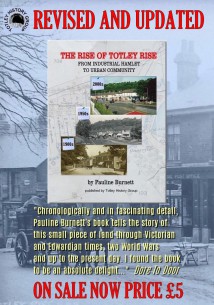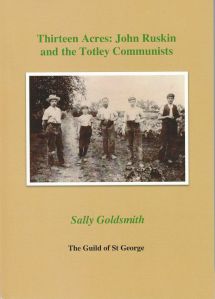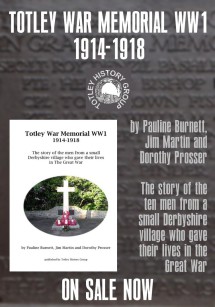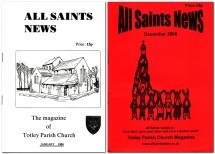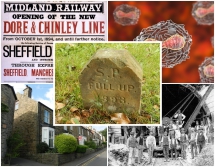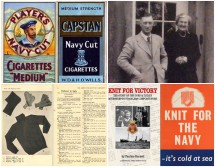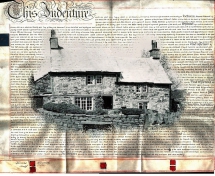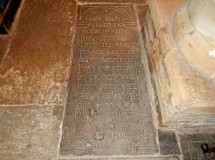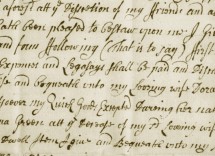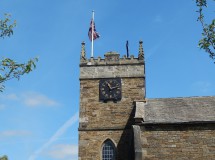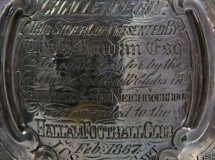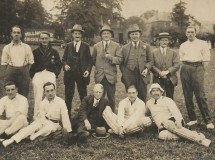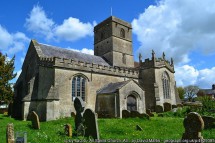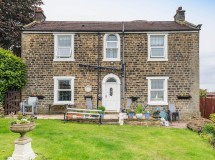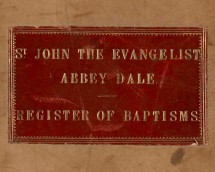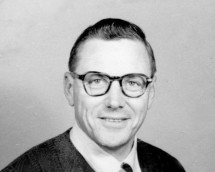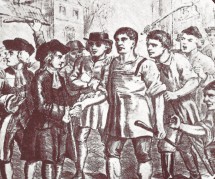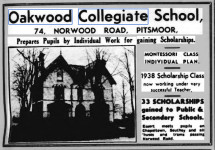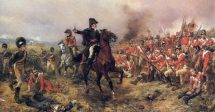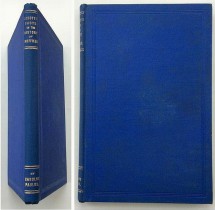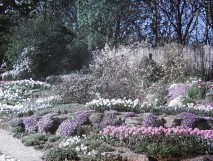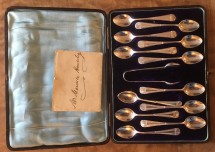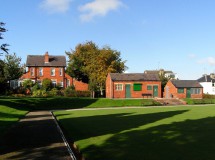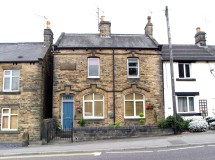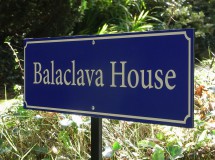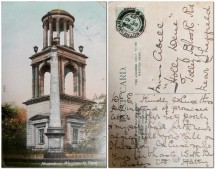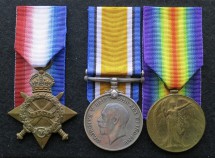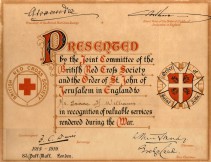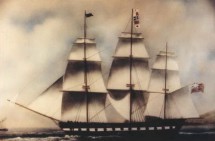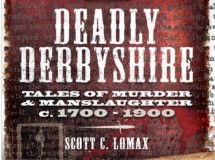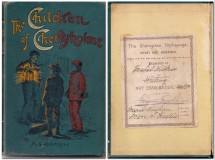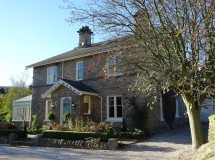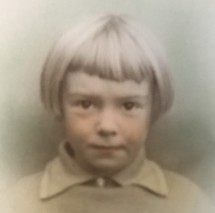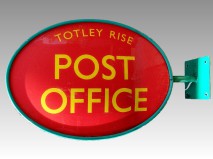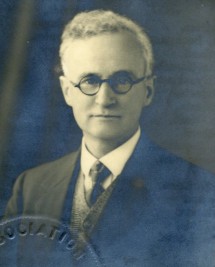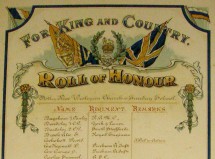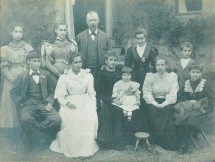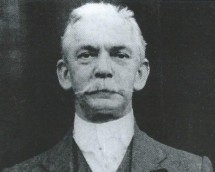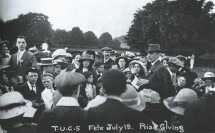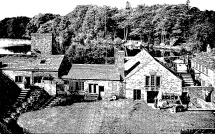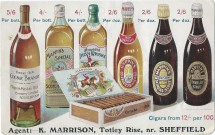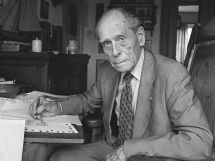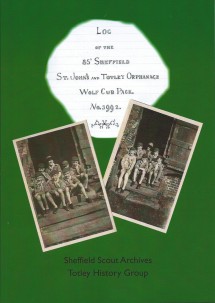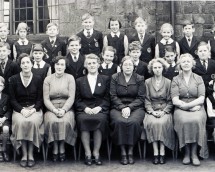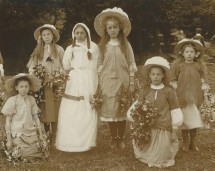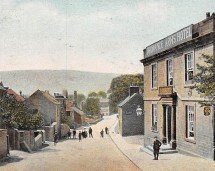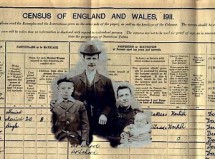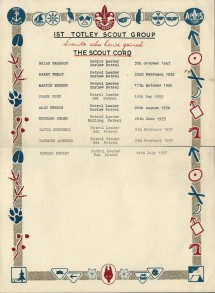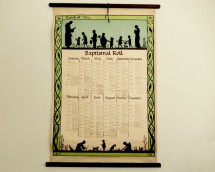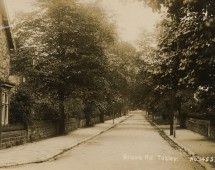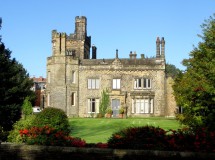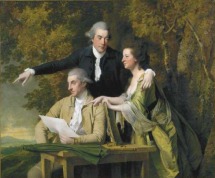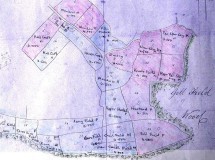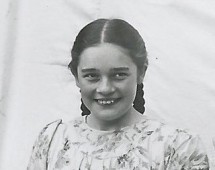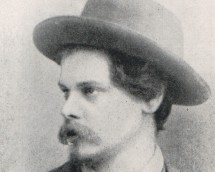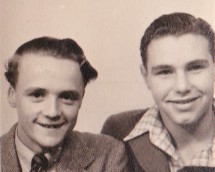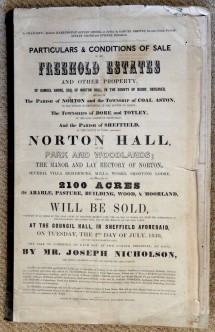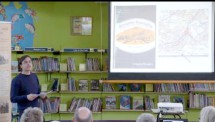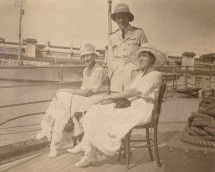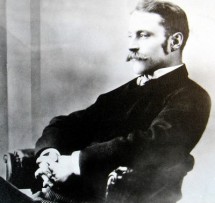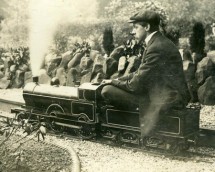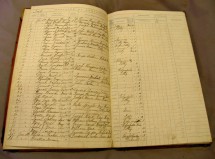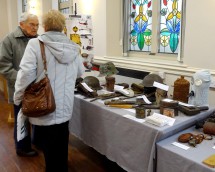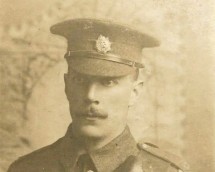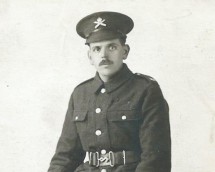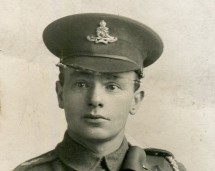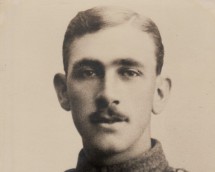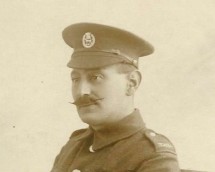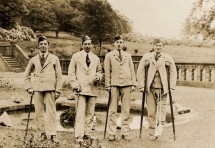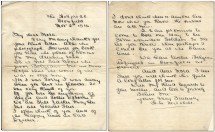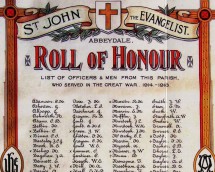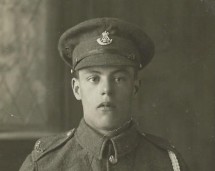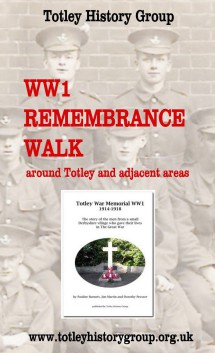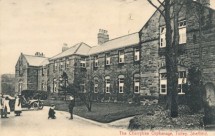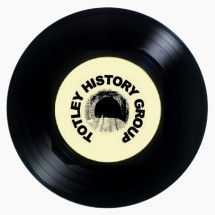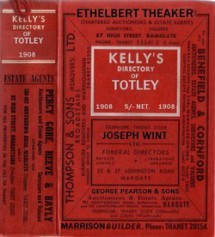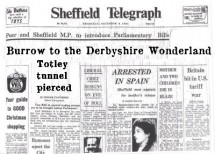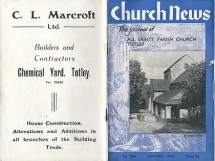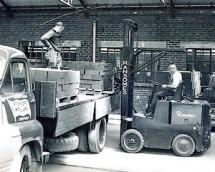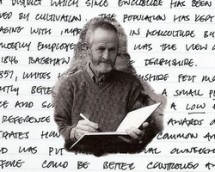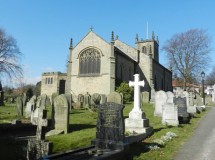Newspaper Archive: 1930s
Thursday 24th April 1930 Sheffield Independent (page 1)
Farm Romance Revealed By Death
Mr. Joshua Tyzack's Wedding Secret
"Land-Girl" Bride
The death of Mr. Joshua Tyzack, the well-known Sheffield man, has revealed a romance in his life of which even his closest friends had no knowledge. Those with whom he
had been in constant touch believed Mr. Tyzack to be a bachelor, but it is now known that he was married, and had been so for about ten years. Mr. Tyzack was the senior partner in the firm of William
Tyzack, Sons and Turner, scythe and saw manufacturers, of Little London Works, Sheffield, but of late years he had farmed a good deal of land at Dore and Totley. One of his farms was the Avenue Farm,
at Totley, and it was to the manageress of this property, Miss Jessie Fisher, he was married ten years ago. "Miss Fisher," a charming woman apparently in her early thirties, was placed in charge of
Mr Tyzack's Avenue Farm about 11 years ago. She managed it with considerable skill, and made a success of the enterprise.
Young Widow Silent
Ten years ago, it is understood, she and Mr Tyzack were married quietly at Scarborough, and agreed to keep the marriage a secret. She continued to managed the farm, and everybody continued to know
her as Miss Jessie Fisher. Mr. Tyzack lived at Wood Lodge, in Abbey lane, Beauchief, a beautiful house built on a substantial scale and standing in its own spacious grounds. A representative of the
"Sheffield Independent" called at Wood Lodge, yesterday afternoon, and asked for Mrs. Joshua Tyzack. The housekeeper said she was in, but after inquiring in the house she returned and said that Mrs.
Tyzack was engaged, and could not be seen. Later Mrs. Tyzack spoke to and "Independent" reporter on the telephone but declined to discuss the matter.
Family Surprised.
At Avenue Farm it was said that Mrs. Tyzack was now living at Wood Lodge, but she intended to return at nights to the farmhouse. The farm itself is obviously a well-0conducted and prosperous
undertaking and is undoubtedly a credit to Mrs. Tyzack's management. It is understood that the news that Mr. Tyzack was married came as a surprise to the family, who knew as little of the romance as
the other intimate friends of the couple. Mr. Tyzack was at one time a member of the Derbyshire County Council and of the Totley Parish Council. He was also a Justice of the Peace For the Eckington
Division. The first intimation to the public that he was married was the report that his widow was represented at the funeral on Tuesday by Alderman Ernest Wilson, the solicitor. Naturally the matter
has given rise to a great deal of interest in the village, where Mrs. Tyzack is well known. She is devoted to farm work, and wears the "land-girl" attire which became popular during the
war.
Thursday 17th July 1930 The Sheffield Daily Independent (page 2)
Housemaids, Housemaid-Waitresses Wanted
Housemaid and General, sisters or friends suitable - Apply Abbeydale Hall Hotel, Dore. 'Phone 702391
Friday 3rd October 1930 Sheffield Independent (page 11)
Sheffield Manufacturer's Will
Mr. Joshua Tyzack, of Wood Lodge, Abbey lane, Beauchief, Sheffield, and of Avenue Farm, Totley, Derbyshire, steel manufacturer and farmer, formerly of Messrs. William Tyzack, Sons
and Turner, scythe and saw manufacturers, of Sheffield, and formerly a member of Derbyshire County Council, left £15, 885; net £4,068. Letters of administration of the property have been granted to
his widow. Mrs. Jessie Matilda Tyzack, of the same address, and the Public Trustee.
Saturday 27th September 1930 Sheffield Independent (page 2)
Preliminary Notice
Joshua Tyzack, Deceased
Majority With Possession.
Dore and Totley
To Be Sold By Auction By Eadon & Lockwood, F.A.I
at their Saleroom, St. James' street, Sheffield, on Tuesday, October 21st, at 4.30 p.m. precisely.
Valuable Freehold Estate
Two Dairy Farms (Avenue Farm and Hallfield Farm), Building and Accommodation Lands, Small Holding and Cottages in 7 Lots. In all about 137 Acres. Printed particulars and Plans may be had of the
Auctioneers, St. James' street; of The Public Trustee, Kingsway, London; or of Ernest Wilson, Solicitor, 19, North Church street, Sheffield.
Saturday 4th October 1930 Sheffield Independent (page 2)
Joshua Tyzack, Deceased
Majority With Possession.
Dore and Totley
(Half a mile from the Villages of Dore and Totley, 1½ miles from the Station, and six miles from Sheffield)
To Be Sold By Auction By Eadon and Lockwood, F.A.I
at their Saleroom, St. James' street, Sheffield, on Tuesday, October 21st, at 4.30 p.m. precisely. Subject to the 1925 General and Special Conditions of Sale. A Valuable Freehold Agricultural Estate, including 2
Excellent Small Dairy Farms, known as Avenue Farm, very suitable for conversion into a Gentleman's Country Residence, with Trout Stream ; also Hallfield Farm, Small Holding and Accommodation Lands,
in all about 137 Acres. To be Sold in 7 Lots. For Printed Particulars and Plans, apply to the Auctioneers, St. James' street; to The Public Trustee, Kingsway, London; or to Ernest Wilson, Solicitor,
19, North Church street, Sheffield.
Saturday 18th October 1930 Sheffield Independent (page 2)
Second Sale. Tuesday Next
Joshua Tyzack, Deceased
Majority With Possession.
Dore and Totley
(Half a mile from the Village of Dore and Totley, 1½ miles from the Station, and six miles from Sheffield)
To Be Sold By Auction By Eadon and Lockwood, F.A.I.,
at their Saleroom, St. James' street, Sheffield, on Tuesday Next, October 21st, at 4.30 p.m. precisely, subject to the 1925 General and Special Conditions of Sale:-
A Valuable Freehold Agricultural Estate, Comprising:-
LOT 1 - Avenue Farm. 41 Acres
LOT 2 - Hollen House. 5 Acres
LOT 3 - Pair of Cottages and Paddock. 3 Acres
LOT 4 - Pair of Cottages. ¼ Acre
LOT 5 - Accommodation or Building Land. 18¼ Acres
LOT 6 - Building Land. 5 Acres
LOT 7 - Hallfield Farm. 63½ Acres
in all about 137 Acres For Sale in 7 Lots.
For Printed Particulars, with Plans, apply to the Auctioneers, St. James' street; to The Public Trustee, Kingsway, London; or to Ernest Wilson, Solicitor, 19, North Church street,
Sheffield.
Wednesday 22nd October 1930 Sheffield Independent (page 8)
Seven lots of land, 137 acres, in the Dore and Totley district, namely, the Avenue Farm, of 4 acres; Hollen House, with six acres; and a pair of cottages and
paddocks, of three acres, were all withdrawn. Another pair of cottages was sold for £350. A lot of 18¼ acres of land was withdrawn; and another of five acres of building land was sold for £750.
Hallfield Farm, consisting of 63½ acres, was withdrawn. Mr. Ernest Wilson, North Church street, Sheffield, the solicitor.
Saturday 1st November 1930 Sheffield Independent (page 2)
Joshua Tyzack, Deceased
Dore and Totley
Avenue Farm and the Surrounding Property withdrawn from Auction on Tuesday last is for Sale by Private Treaty. Particulars may be had of Ernest Wilson, Solicitor, North
Church street, or of Eadon & Lockwood, F.A.I., St. James' street, Sheffield.
Friday 23rd January 1931 Newpaper unknown
Death of Mr. William A. Milner, J.P.
Devotion to Public Work
Deputy-Lieutenant of Derbyshire
By the death of Mr. William Aldam Milner, J.P., of Totley Hall, Sheffield, yesterday, and Deputy-Lieutenant of Derbyshire, a popular an well-known figure in the public life of Sheffield and
Derbyshire has been removed. Mr Milner, who was in his 77th year, had been in failing health for some time, and recently underwent a serious operation, from the effects of which he did not recover.
Mr. Milner will be remembered for his association with the old Ecclesall Board of Guardians for 41 years until that authority was merged in the Sheffield Board of Guardians in 1925. Mr. Milner was
chairman of the Ecclesall Board for 22 years.
The only son of the late Mr. W. P. Milner, who was a J.P. for Derbyshire and the West Riding of Yorkshire, Mr. W. A. Milner was born at Dykes Hall, Wadsley, 1854.
Subsequently the family lived at Meersbrook Park, in the house which is now the Ruskin Museum. Mr. Milner was educated at Repton and Trinity College, Cambridge, taking his M.A. degree in 1878. He
later qualified as a barrister-at-law, and practiced in the North-Eastern circuit for some years.
Great Public Work
He soon developed a liking for public work, and in 1884 he was elected a member of the Ecclesall Board of Guardians (on which his father had sat for 20 years). After being vice-chairman for some time
he was chosen to succeed the late Mr. W. Greaves Blake as chairman, and he presided over the deliberations of the Board to the satisfaction of all the members. Although his heath was such, at any
rate latterly, that he sometimes expressed a wish to retire, he was re-elected over and over again. Mr Milner had several evidences of the respect in which he was held by his co-workers on the Board.
In 1905, when he had completed 21 years' service, he was presented with a set of three rose bowls. Some time earlier, when the workhouse hospital was extended, his name was given to one of the
blocks.
Besides the chairmanship of the Ecclesall Board, Mr. Milner held those of the Norton District Council and the Totley Parish Council. He was also a member of the
Derbyshire County Council from 1888, and of the Education Committee. He was appointed a magistrate for the county of Derby in 1884, and for the West Riding of Yorkshire in 1887. He was a director of
the Sheffield and Rotherham Banking Company, and remained a member of the Local Advisory Board when that company was amalgamated with Williams Deacon's Bank. He was an Income-Tax Commissioner for the
West Riding, and was on the Council of the Derbyshire Public House Trust Company, and a member of the North Derbyshire Isolation Hospital Committee.
Mr. Milner was a trustee of the Dore and Totley Church Schools, and a member of the Trusts of the Holmesfield Church, and St. John's Abbeydale. He was also a trustee
of the Sheffield Girls' Charity School and a member of the committee. He also took a great interest in his old school at Repton, of which he became a Governor in 1906. In 1911 Mr. Milner was
appointed High Sheriff of Derbyshire. Th office entailed on him exceptional responsibilities the year being that in which the coronation of King George and Queen Mary took place.
He was also an ardent horticulturalist, and not only delighted in the beautiful gardens which surrounded his house at Totley, but took equal pleasure in allowing others to share. Each year he threw the gardens open in order that the public might enjoy the beauties of the daffodils and tulips.
Sport and Horticulture
He had a great knowledge of horticulture, and took much pleasure in his well-known and wonderful collection of choice daffodils and alpines, many of which were produced in his garden by
hybridisation. For many years he was president of the Midland Daffodil Society, and he was often called upon to act as a judge of daffodils throughout the country.
Many forms of open air sports and games appealed to him. He was an excellent shot, a good fisherman, and he also took great interest in the formation of the Sheffield and
District Golf Club at Lindrick, being one of the original members in 1891 and captain of the club in 1892. He often played at Lindrick until disabled by lameness, but though deprived by this of many
things he most enjoyed, his inability was borne with a brave and cheerful spirit.
Memorial Gift
Mr. Milner was married in 1883 to Miss Sarah Elizabeth Roberts, sister of the late Sir Samuel Roberts, M.P., of Queen's Tower, and is survived by her and a daughter and son, Mrs. William Wilson,
jun., Horsley Gate, and Mr. William Alfred Milner. Another son, Roy D. P. Milner, of the Sherwood Foresters, was killed in action in September, 1914, while gallantly retaking one of the British
trenches which had fallen into the hands of the enemy at the Battle of the Aisne. In memory of him, Mr. and Mrs. Milner decided to build a parish room at Totley, to serve as a centre for the
activities of the parish of Dore and Totley. Later Mr. Milner showed his interests in the spiritual welfare of the people in his neighbourhood by giving a donation of £2,000 and land for the erection
of a church at Totley. When the old Ecclesall Board, as such, ceased to exist in 1925, Mr. Milner was returned unopposed as the Guardian for Totley on the Sheffield Board.
During the war, Mrs. Milner received the honour of O.B.E. in recognition of her work on behalf of the Red Cross movement in Derbyshire. One of the offices she held was
that of vice-chairman of the Eckington Division of the Derbyshire Red Cross Society.
Tuesday 17th March 1931 The Sheffield Daily Independent (page 4)
New Council Offices
[photo with caption: Abbeydale Hall which has been bought by Norton Rural District Council for use as offices.]
Abbeydale Hall for Norton.
Long-Felt Need Overcome.
The Norton Rural District Council. which for some time has been hampered by lack of proper offices and for a meeting place, has overcome the difficulty by purchasing Abbeydale Hall. The hall has had
a varied existence. It was built on the Derbyshire side of Dore railway station as a residence for the late Mr. Ebenezer Hall, who from a humble beginning rose to a high position in the firm of
Messrs. Martin Hall & Co., Ltd., electro-plate and nickel silver ware manufacturers, Shrewsbury Works, Broad street, Park, Sheffield. When the Midland Railway Company (now L.M.S.) were seeking
powers to cut through the hills to Grindleford for the Dore and Chinley line they were met by opposition from the last E. Hall on the ground that the railway would detract from the amenities of
Abbeydale Hall, and as a consequence and embankment was thrown up which completely shut the railway from the view of anyone at the hall.
Once a Hotel
Later it was turned into a private residential hotel particularly adapted for the use of golfers, small week-end conferences, etc., and among others who have stayed there were the teams of Yorkshire
County Cricket Club and the Australian team. Standing in beautiful grounds it appeared particularly suitable for its new requirements.
Now it has been purchased by th Norton Rural District Council to fill a long-felt need. For some time the Council has been handicapped by the need for adequate Council offices, and was only able to
find sufficiently suitable premises outside its own borders, having offices in Camping lane, Woodseats. The Council also needed premises for its meetings, and was allowed the use for a temporary
period of the Sheffield Union offices, West Bar.
Cheaper Than Building
To meet these difficulties the Council had earmarked land at Twentywell lane for the purpose of building offices and headquarters. However, when the opportunity arose of buying Abbeydale Hall for
£3,250 it was seized because under most economic and moderate arrangements it would not have been possible to have built premises to meet the Council's requirements for that amount. It is possible
that in addition to the use made of the Abbeydale Hall by the Council some of the County Administrative Officers will also be established there.
Friday 20 March 1931 Sheffield Daily Telegraph
Dore and Totley Players
The Dore and Totley Union Church Dramatic Society gave the first of two performances of the three-act comedy, "The Optimist," last night. The players were Messrs. R.
Muxlow, W.W. Green, H.M. Hartley, W.N. Stanley, B. Whitehead, and E.D. Nicholls, and Misses C.M. Whitehead, H.M. Plumbe, E. Walker, and P.M. Seed. Miss W.J. Parker was the producer, and Mrs. W.N.
Stanley was stage manager. The second performance will be given to-night.
Saturday 4th April 1931 The Sheffield Daily Independent (page 2)
Wednesday, April 15th, at 11.
In the High Court of Chancery.
Siddall v Kendrick and Another
Abbeydale Hall Hotel, Dore
Sale by Auction of the Residential Hotel Furniture, Full size Billiard Table by Orme; Eavestaff Auto-player Piano; Gilbert Cabinet Gramophone; Carved Oak, Inlaid and
Pollard Oak Side-Boards; Mahogany Bureau; Gilt Mirrors; Mahogany 16ft Bookcase; Dining, Coffee and Card Tables; 11 Doz. Carved Oak Jacobean, Light Oak and Bentwood Dining Chairs; Carved Oak
Langsettles and Chairs; Wilton and Axminster Carpets, Linos; 19 Bedsteads, Bed and Table Linen, Blankets; Bedroom Furniture in Ash, Satin Walnut, Burr Walnut, Jacobean Oak and White Enamel; 15 Doz.
Stainless Knives, 6 Doz. Fish Knives, 40 Doz. E.P. Spoons and Forks; Dinner, Tea and Glassware; Cooking Utensils; Garden Effects, etc. Nicholson Barber and Hastings. F.A.I. 3 High street, Sheffield.
Telephone 26209.
Monday 11 May 1931 Sheffield Daily Telegraph
PLUMBE. - On May 8th, suddenly, at Widdecombe, Devonshire Road, Totley Rise, Kate, widow of the late William Alvey Plumbe, of Mansfield, aged 76 years. Service, Union
Church, Totley Brook Road, to-day (Monday), at 12 noon; interment, Mansfield Cemetery at 2.30.
Friday 15th May 1931. Mansfield, Sutton and Kirby Chronicle (page 5)
Late Mrs. Kate Plumbe
Death and Funeral of Former Mansfield Lady
It is with regret that we record the death of Mrs. Kate Plumbe, of Totley, Derbyshire, and formerly of Linden House, Chesterfield Road, Mansfield, who
passed away on Friday after an illness lasting about a year. The late Mrs. Plumbe was the widow of Mr. William Alvey Plumbe, and following the death of her son, Mr William Collingwood Plumbe, on
active service, she took over the managing directorship of Messrs. Plumbe and Richardson, Ltd., printers, of Mansfield. During her residence in Mansfield, Mrs Plumbe was closely connected with the
Mansfield Congregational Church, where for a number of years she was the leader of the Young Women's Class. She was also an ardent temperance worker. She was a native of Plymouth, but resided in
Mansfield for about 40 years. A family of one son and six daughters are left to mourn their loss.
The funeral took place at the Mansfield Cemetery, on Monday, and was conducted by the Rev. W.J. McAdam, a former Mansfield Congregational Minister. The interment was
preceded by a brief service at Totley.
The principal mourners were, Mr. and Mrs. C.C. Plumbe (son and daughter-in-law), Mrs Wilkie-Brown, Mrs Don, Miss H.H. Plumbe and Miss G.E.B. Plumbe (daughters), Mrs. C.W. Plumbe (daughter-in-law), Mr. Mack (son-in-law), and Mr. and Mrs. Crabtree (Ilkley). Among those present at the graveside were Rev. J. Arnold Quaill, The Directors of Messrs Plumbe and Richardson, Ltd., Mr. J.J. Allin, Mr. G. Baxter, Mr. A.E. Cripwell, all the members of the staff of Plumbe and Richardson, Ltd., Mr. J.E. Allcock, Mr. and Mrs. H.A. Meggitt, Mr. Pogson, Mr. E. Hunt, representing Messrs. Kempson and Co. Ltd., Mr. and Mrs. H. Slack, Mr. E. Woolley, and Mr. Marshall of Sutton-in-Ashfield, Mr. Knight and Mr. Somerton (old employees), Mrs. R. Carruthers, Mrs. W. Hutchinson, Mrs. Bond and members of the Ladies' Class in connection with the Congregational Church, Mansfield. The hymn "There is a Green Hill Far Away," which was one of deceased lady's favourite ones, was sung by the Ladies Class at the graveside. The coffin was borne to the grave by six of the employees, namely Mr. G. Rhodes, Mr. G. Wilkinson, Mr. W. Hollingsworth, Mr. A.G. Baxter, Mr. P. Williams, Mr. H.E. Baxter.
Wreaths and flowers were received from:- Queenie and Conway; Agnes and Win; Winifred and Hilda; Olive and Tom; Gwyneth; Jack and Therle; Loona and Rayne; Maude and Arthur; Nurse and Hellen Smith; Miss Hodgkinson, Phillis Cartledge and Nellie; Mr. and Mrs. Hedley Crabtree of Ilkley; The Directors of Messrs. Plumbe and Richardson Ltd.; The employees of Messrs. Plumbe and Richardson Ltd.; Teachers and Scholars of Totley Union Church; Miss M.H. Hartley; G.E. Taylor and E. Taylor; Mansfield Congregational Sunday School; Old Scholars of Mansfield Congregational Sunday School Class; Messrs. Kempson and Co. Ltd.; Mr. and Mrs. H. Slack; , George and Bill.
Tuesday 23rd June 1931 The Sheffield Daily Independent (City page)
New Companies
Totley Estates, Ltd., Sheffield. Private company. Registered 20 June. Capital £100 in £1 shares. Objects: To acquire, for investment or resale, and to traffic in land,
house, and other property, to prepare building sites, etc. The subscribers (each with one share) are: C. I. Greenway, 4, Bank street, Sheffield, solicitor's managing clerk; J. H. Redfearn, 4, Bank
street, Sheffield, solicitor's clerk. The first directors are not names. Secretary: C. I. Greenway. Solicitors: H. Stone, 4, Bank street, Sheffield. Registered office: 4, Bank street,
Sheffield.
Wednesday 9th March 1932 Derby Daily Telegraph (page 4)
The Art of Elocution
A little girl of 13 Eileen Winifred Cooper of Totley surprised and delighted the audience at the musical festival at Derby Temperance Hall yesterday with her elocution,
she was awarded the bronze medal for verse, speaking and having previously won prizes in similar competitions at Matlock, Buxton it may be said that she possesses talent beyond the
ordinary.
She received 89 marks a high percentage which was excelled in the open class by Miss Phyllis M Kirby of Spondon who recited Robert Bridges The Nightingale another
exceptionally good elocutionist was Miss Mualch May Sumner of Derby High School a daughter of Mr. Gerald Sumner who was 2nd in the class for child under 16.
Saturday 25th June 1932 Derbyshire Times and Chesterfield Herald (page 15)
Police Brevities
Totley - For keeping a dog without a license at Totley on June 9th, Oscar Creswick (50), Avenue Farm, Totley, farmer, was fined 10s. at Dronfield on
Monday.
Saturday 30 July 1932 Sheffield Daily Telegraph (page 5)
Monday, August 8th, at 11 o'clock at the Mart, Aldine Court, Sheffield.
By Order of Messrs. Thomas Glossop & Sons.
Salvage Stock (Damaged by water, owing to the flooding of their premises by rain-water), comprising Hair Clippers, Scissors, Table and Pocket Cutlery, Nail Clippers and
Files, Razors, Safety Razors, Spoons, Tea Infusers, Mounted Glassware, Manicure Sets, Leather Bags and Pouches, Hair and Shaving Brushes, Combs, Soaps, Surgical Knives, Nutcracks, Tin Openers, Pencil
Sharpeners, Tools, Toys, Dolls, Canteen and other Cases, and Miscellaneous effects. Removed from No. 8 and 9, Norfolk Market Hall, for Convenience of Sale.
Thursday 16 March 1933 Leeds Mercury (page 7)
Shop Flood Damages
Sheffield Corporation to Pay £225 to Local Firm.
Thomas Glossop and Sons, cutlery and fancy goods dealers, Norfolk Street, Sheffield, were awarded £225 damages at the West Riding Assizes, in Leeds, yesterday, against
Sheffield Corporation for negligence. The Corporation owns a shop occupied by Glossop and Sons, and in July, during a heavy thunderstorm, flooding occurred in the shop. Glossop and Sons had
complained previously to the Corporation of water coming in, and they declared that a fall pipe had not been properly cleaned.
Monday 10th September 1934 The Daily Independent
500 New Houses For Sheffield
Building Without Subsidy
Estates Plan
Nearly 500 houses are to be built by the Sheffield Corporation - and all of them will be without Government subsidy. Alderman C. W. Gascoigne, chairman of the Sheffield
Estates Committee, told a "Daily Independent" reporter on Saturday that the houses are being built to fill up spaces on existing Corporation housing estates. "We have the land there, all the street
works have been provided, and the houses are wanted," he said. "As they do not come under Slum Clearance schemes, the houses will have to be built without subsidy. Houses are still required,
however, apart from re-housing tenants from slum areas, and we have decided to go forward with the scheme." A start is being made by building 218 non-parlour type houses on the Brushes and Stubbin
estates, where 48 houses will be built, Longley estate (46 houses), Manor Estate (122 houses), and Norwood Estate (two).
Tenders Invited
On Saturday the Corporation invited tenders from contractors for the building of the houses. Other houses to be built later will be on the Totley Estate, where building ceased when the Government
withdrew their subsidy, except for houses concerned with slum clearance schemes. There were some fears a few months ago that the Corporation might proceed to build houses at Totley for the re-housing
of slum tenants, but apparently this is not to be the case. By building the houses without a Government subsidy, the Corporation will sacrifice about £300 per house spread over 40 years. A Ministry
of Health inquiry is to be held at the Town Hall on 19 September into the application of the Sheffield Corporation for the borrowing of £12,890 for sewerage works.
Saturday 30th June 1934 The Sheffield Daily Independent (page 10)
Secure Your Ideal Home Now on the Sunnyvale Estate, off Main Avenue, Totley. [Advertising Feature]
The Sunnyvale Estate is a most appropriate name for the new estate which is being developed by Mr. C. L. Marcroft, of Heatherfield, Totley, on Sunnyvale road, just off the main Sheffield to Totley
road. It is only to be a small estate, comprising 31 semi-detached houses, but it is situated in the most delightful surroundings and is , literally, encircled by green fields. In a gentle fold in
the land, within about five minutes' walk of Totley motor 'bus terminus, the houses which are now being built have an uninterrupted view of the lovely country over towards Holmesfield. Thus those who
are fortunate enough to buy these houses will have all the joy of living in the country and yet will be able to take advantage of the amenities of the city. The estate is only about two or three
minutes' walk from the Totley bus route, and therefore barely 25 minutes' journey from then centre of Sheffield.
Two Types
Two types of houses are being constructed, and may be built either of an art stone, a hard-wearing concrete material or of brick. There is no differentiation in price, the inclusive figure for each
house being £475. This includes road charges, etc. The houses may be bought on easy terms of 12s. 9d. a week after payment of a deposit of £47 10s., the weekly payment of the purchase price being no
more, if as much, as would be paid in rent for houses of similar type. The rates, too, are very low, and this area being within the district which was formerly Norton Rural District, a definite
advantage is to be gained through the differential rating.
Three-Bedroom Type
In the construction of the houses, Mr. Marcroft is doing his utmost to cater for different requirements. The first type of houses has a hall, two rooms, and a kitchen on the ground floor and three
bedrooms with a bathroom and separate lavatory on the first floor. The second type has a larger hall with one large room and a large kitchen on the ground floor and three bedrooms, a bathroom and
separate lavatory on the first floor. In the first type of house there is a good sized hall from which are doors to the kitchen, the dining room and the drawing room. These doors are all very
conveniently placed to provide the maximum amount of space in the hall and in the rooms.
Wide Bay Windows
The dining room and the drawing room each has a floor space of 12 feet by 11 feet and in addition each has a wide bay window. These windows virtually occupy the whole of one side of each room. In
each room, too, stoves will be installed to suit the purchasers. The kitchen in the first type of house has a tiled floor and is ten feet by eight. Provision is made for a gas or electric cooker, and
there is a deep sink with a white tiled surround with a draining board. There is also an electric point. A large cupboard is built in, and leading from the kitchen is a large pantry. The coal house
is outside. Upstairs are two large bedrooms, each 12 feet by 11 feet and a third bedroom, 8 feet by 7 feet. Both the large bedrooms have bay windows corresponding with the bays in the ground floor
rooms. The bathroom is over the kitchen and contains a large airing cupboard.
Electric Equipment
Throughout the houses the electric light switches are sunken and a special feature which is designed to save trouble to occupants is the placing of the electric light and gas meters in elegant
cupboards in the porch. These cupboards might be used for seats or put to a variety of other uses. The second type of house, which is very similar in outward appearance is very attractively designed.
The hall is exceptionally large and square and the one room (other than the kitchen) is 20 feet by 12 feet. It has windows at the front and back and the front window is a large bay. It has two
lighting points with independent switches. The kitchen in this type of house is 11 feet by 8 feet and is quite large enough to be generally used. It contains a modern combination range and an
exceptionally handsome built in cupboard with drawers. Leading from it is the pantry.
Metal Window Frames
On the first floor is a large landing on which is the drying cupboard and the bedrooms are larger than in the other type of house. The two principal bedrooms both have bay windows and the third bedroom has a convenient shape. In the bathroom is a tiled surround for the bath and the lavatory is separate. Throughout the houses metal window frames are being used and these in addition to having a pleasing appearance, open in such a way as to facilitate window cleaning. Each house has a garden back and front, and an entrance with double gates with plenty of room for a garage. Inquiries regarding the houses may be made on the site at any time during the day or evening, or at the Heatherfield Estate, which is also at Totley, on the main road just above Totley Rise.
Halifax Building Society
Intending purchasers of houses on the Sunnyvale Estate may obtain mortgages on very favourable terms from the Halifax Building Society, whose local office is at 53, Surrey street,
Sheffield.
The Contractors
The "Reliance" Metal Windows have been supplied by Messrs. Williams and Williams, Ltd. of Chester, whose local representative's address is 29, Briar road, Nether Edge, Sheffield. Messrs. Charles
Credland, Ltd., the well-known paint and varnish manufacturers, of Queen street, Sheffield, have supplied the paints; and the timber comes from Joseph Smith and Sons, Ltd, of City Sawmills, Shoreham
street, Sheffield. The asphalting has been entrusted to G. R. Lister and Son, of Young street, Sheffield, and the ironmongery is supplied by Alfred Shaw, 26, Duke street, Sheffield. Mr. F. Gratton,
of 17, Princess road, Dronfield, has been responsible for the plumbing and glazing, and the electrical installation is by Ratcliff and Co., The Wicker, Sheffield.
Tuesday 11 December 1934 Sheffield Independent (page 7)
'Watched' Cricket With Wife's Eyes.
Blind Sportsman Bereaved.
Mr. Thomas Glossop, of "Pattysbrooke," Totley Rise, Sheffield, has suffered the loss of his "second sight" by the death of his wife, Mrs. Martha Walton Glossop, at the age of 79. An
inveterate lover of cricket, he has attended the matches at Bramall lane, Sheffield, since he was a boy, and his enthusiasm for the game was so great that when he lost his sight, 16 years ago, he
continued to "watch" the game through the eyes of his wife. Until his retirement a few years ago Mr Glossop was a familiar figure in the Norfolk Market, Sheffield, where he ran the business of
Messrs. Thomas Glossop and Sons, cutlery dealers. The business is now carried on by his son, Mr. William Glossop.
Autographed Trousers
A number of autographed treasures he has received from Australian cricketers in their visits to Sheffield, can still be seen at the stall in the market. Most of the Australian cricketers have stayed
under his roof at some time or other. One of the treasures is a a pair of flannel trousers autographed by members of the Australian cricket team which he once exchanged with Mr. Hopkins for a razor.
The exchange was the result of a mock "court martial," at which it was decided that the trousers could not be worn again. The autographs of George Robey, R.G. Knowles and many other comedians also
figure on them. The firm supplied the cricketers cutlery in Hugh Trumble's days. Mr. Glossop is one of two people still alive who sold "bricks" for the building of Hanover Street Methodist Church,
Sheffield with which both he and his wife were associated until their removal to Totley. The funeral is to take place at Dore at 2.30 to-day.
Tuesday 30th June 1936 Gloucester Citizen (page 12)
Drowned in a Hole in Road.
John Martin Fox age 2½ of Chapel Walk Totley Sheffield, was drowned in a hole in the road at Totley today. It is understood that workmen were repairing a water main in
hole and were away at lunch at time of accident.
Saturday 25th July 1936 The Daily Independent (page 2)
Fifth Sale, Tuesday Next, at 4.30 At a Low Reserve
Small Modern Villa at Totley
To be Sold be Auction by J. J. Greaves & Sons, F.A.I., in their Property Mart, Aldine Court, High street, Sheffield, on Tuesday Next, 28th July, 1936,at 4.30 (subject
to the Law Society's Conditions of Sale, 1934, and to Special Conditions to be then read).
No. 9 Grove Road, Totley Rise, a Small Modern Brick-built Semi-detached Villa, with Sunny Garden. Vacant Possession on completion. The Site contains 517 square yards or thereabouts, and is Leasehold
for 800 years from 24th June, 1925, at an Annual Ground Rent of £7.
The Property is sold with the benefit (in common with others) of a piece of land lying at the West end of the Totley Brook Estate. Cards to View and full particulars from The Auctioneers, Aldine
Court (Telephone 25616); or from Arnold Brittain, Solicitor, 12, Norfolk row, Sheffield.
Tuesday 27th September 1938 The Daily Independent (page 4)
"Country Life" On Totley Estates
By Patrick Bond
A visit to the new housing area which is rapidly springing up around Totley inspires me to say something about the adaptability of Sheffield for new housing estates. The
hilly character of the city has been used to tremendous advantage by builders and surveyors, and new estates are mostly blessed with a healthy position, high above industrial murk and surrounded by
scenery of particularly good quality. This is especially true of Heatherfield, Laverdene estate and the Corporation's estate at Totley. They are six miles away from the centre of Sheffield, and when
you turn your back to the houses and look towards the magnificent hills in the direction of Baslow, you can imagine you are right out in the country.
Pleasant Spot
The modern tendency for city workers to live in country is a direct outcome of the strides that housing has made during the past decade or so. It would be difficult to visualise a more pleasant spot
in which to live than Heatherfield. Heatherfield is residential. The houses are all of attractive design, situated in delightful gardens, and walking round the roads, I was particularly impressed by
thick privet hedges, neatly clipped that are an admirable substitute for fences. A number of the dwellings in Heatherfield are bungalows. The impression I gained from conversations with people living
in them was that the bungalow is an attractive proposition - a sort of happy medium between a house and a flat. It is surprising that the Corporation have not experimented with bungalows on some of
their larger estates. Such dwellings would be far better for old people, who no longer have the responsibility of a family, than an ordinary house.
'Bus Tickets
In Heatherfield the roads are effectively dressed by grass verges and every care is taken to give the place an appearance above reproach. Heatherfield is as attractive as its name. You may know
Letchworth Garden City. It has a reputation of being an ideal place to live. In outward appearance Letchworth and Heatherfield are very much alike. Indeed the latter might be a corner of Letchworth
taken to a Yorkshire setting.
Leaving Heatherfield, I explored two estates of rather different type on the opposite side of the main Baslow road. Presumably life here does not demand such a generous income as in Heatherfield, but
all the same a weekly bus ticket to the city and back costs 4s 8d, - and this is reflected in the type of population. By this I mean that people living in Corporation houses on the Totley estate are
of different mental and social outlook from those on estates nearer the centre of the city. Which leads to an interesting point. It seems to me that the higher people are in the "social scale," the
less gregarious they become. They do not want any organised social life, but prefer to follow cultural and recreational pursuits of their own making. One could speculate indefinitely as to the
reason. Fundamentally it is a question o a preference developed by education, instinct and environment over a period of years; and opportunities which have enabled the individual to be competent to
chose his own pursuits judiciously are not within the reach of everyone. Thus it is that social workers are most active in an area whose population has not had such opportunities, and these areas are
usually the ones which re-house slum-clearance tenants.
Individual Interests
Laverdene Estate - a private one - and the Corporation neighbour, are full of people who like to be left to themselves. Interests there are more individual than communal. One organisation likely to
lessen this tendency id the Co-operative Women's Guild, which meets once a week, and doubtless is a welcome medium for the exchange of views. There is also the Totley Sports Club - actually in the
old village of Totley, but these are about the sum total of amusement the estate dwellers can find outside the home and the city. Nightly trips to Sheffield itself are, not surprisingly, beyond the
financial scope of many of the people, and the result is that their home has become the focal point of their lives.
Happy
So I set out to find out whether thy were bored - whether the home, with perhaps a little club and guild thrown in for variation, offered sufficient of life's gifts. I found it does. The people in
Laverdene and Totley estates are happy. Men have gardens, women have homes and youngsters can play to their hearts' content in Green Oak Recreation Ground. Gilbert wrote something to the effect that
life would be exceedingly last with nothing at all to grumble at. Laverdene and Totley people think so too. They would like a cheaper bus ride to the city for example. They would sometimes like life
to be a little less tedious. They would like an up-to-date school more handy than the nearest one is at present. But they do not think these disadvantages of life in their new homes, and these
estates are yet another argument in favour of the re-housing programme which is altering the face of English towns and cities.
Wednesday 18 January 1939 Sheffield Daily Telegraph (page 4) Extract
A Sheffield Woman's Diary
Blind Sheffield Sportsman
I have met this week and octogenarian and septuagenarian (try these in your next Spelling Bee) both interesting men. To give age its precedence, I will tell you first
about the octogenarian, Mr. T. Glossop, of Brinkburn Vale Road, Totley, who is 86 next month. Quite blind, he is a familiar figure at football and cricket matches, a popular character in Sheffield
sport. For many years he has been on friendly terms with visiting Australian cricketers, and the leading men often stayed at his house. He had met Don Bradman and was familiar with the older
cricketers, Victor Trumper, Charlie McCartney [Macartney] and Jack O'Connor. He can tell an off-side hit by the sound of the ball on the bat and get a good idea of how the game is progressing. With
football it is quite easy to tell by the varying roar of the crowd how the game is going on. There is never any doubt in his mind as to who has scored a goal.
Talks Among The Shavings.
Mr. Glossop is notable for a really brilliant memory and can speak of things in the days when Sheffield was visited by such people as Blondin, who walked the tightrope in the Botanical Gardens amid
deafening cheers; W.G. Grace; and past Royalties. Sport, when Mr. Glossop was a boy, was not encouraged as it is today. He was a pioneer of Sheffield cricketing among his own circle, and when a small
club was formed, he and his fellow members used to meet in a little joiner's shop to discuss their important business. Sitting amongst the shavings, they had to talk in the dark, for the owner of the
shop would never allow the light to be used for such unprofitable goings-on. Mr Glossop used to get up at 3 or 4 o'clock in the mornings to rush though his work and be able to see cricket
matches.
Hey-day Of Top Hats
A portion of Bramall Lane ground was in those days used for keeping pigs, these animals being indifferent to the noise. Mr. Glossop has seen the famous Grace and George Ullyott knock balls right over
Bramall Lane, breaking windows in houses in Bramall Lane. But alterations have made this impossible now. Mr. Glossop was in the procession when Firth Park was opened by King Edward VII, then Prince
of Wales. He went to St. Mary's School, and later to Brunswick School, and remembers the sound birchings that were administered in those times. But school finished for him when he was 11, and he
worked at Samuel Sanderson's, a hatter's shop in Fargate. This way the hey-day of the silk top hat, and Mr. Glossop says that even the sweep who swept the chimneys at his home always appeared in a
silk top hat. They were worn by working men who could get them for 7s. 6d., as well as by wealthier people.
Cash Lads in Etons.
The chief drapers in those days were Graves and Henderson, of High Street. Here, there were a great many small boys, dressed in Eton suits, called "cash lads." Their job, when a purchase was made,
was to rush with the money from the shop assistants to the cash desk for change. "They were sharp little beggars who ran about like mice," chuckled Mr. Glossop. Then he went on to tell, how Coles
corner used to consist of three or four lock-up shops, one of which was advanced enough to possess a little van. He can remember accurately the names and positions of all the shops in the main
streets of Sheffield.
Tuesday 24 January 1939 Sheffield Star (page 6)
A Totley Rise Road
Sir, - I wonder if anyone could enlighten us on the question of constructing a roadway worthy of the name of Glover Road, Totley Rise. The authorities appear to have
reached a state of indifference over the matter - the road has been in existemce for more years than I can remember, and the time has come when something should be done. - Yours, etc. W.G. Jacques.
Glover Road, Totley Rise.
Saturday 18 March 1939 Sheffield Daily Telegraph (page 16)
Local Patents
494,627 - H. J. Biggin, "Westgrove", Grove Road, Totley Rise. Improvements in Composite Facing Tiles. A composite tile consists of a metal facing plate, e.g. of stainless
steel, secured by mechanical means to a base, e,g, of earthenware or wood. The plate may be attached by rivets, bolts or wire ties secured thereto or by solder run into holes. According to the
Provisional Specification, the plate may be secured to the base while the latter is still plastic.
Wednesday 26 July 1939 Sheffield Telegraph and Independent (page 4)
Sheffield Chain of 24 Rescue Posts
Plans Made for Swift Action in Bombed Areas
Arrangements have just been completed for providing 24 A.R.P. cleaning and rescure stations in Sheffield at a cost of £24,000. The aim is to distribute the stations throughout the city so that any
particlular district which may be bombed can be quickly served. Apart from thus the authorities take the view that rescue and decontamination personnel should be so spread over the city as to avoid
serious interference with the operation of the services in the vent of one or more stations being wiped out. Here is a list of the stations....
includes...
Southern Division
Whirlow House (training school)
Brinkburn Grange (Abbeydale Road South)
Millhouses Lane (Woodholm Road corner)
Broadfield Road (adjoining corporation washhouse)
Chesterfield Road (vacant land on school site near Cobnar Road).
.....
Limited Choice of Sites
In addition to providing a proper distribution of stations, the arrangements have been governed by the limited number of suitable sites available, and by the necessity of providing stations at sucj
intervals as will ensure rescue and decontamination personnel not having to travel more than a mile when returning to their stations. The cleansing stations are not only required for the
decontamination of personnel who may be fouled by liquid gases, but also as stations to which the various sections of the personnel may return after carrying out their duties and change from their
heavy protective equipment into ordinary attire. These stations will be used as headquarters by the City Engineer's Department personnel when on duty, and also when at rest, and the cleansing
facilities will also be available for all other A.R.P. personnel, such as auxiliary fireman and first-aid workers, who many be contaminated.
Search Our Website Here
September
October
November
Unless stated otherwise our meetings are held in Totley Library on the 4th Wednesday of each month at 7.30pm.
Pauline Burnett's book The Rise of Totley Rise has been revised and updated. It tells the story of this small piece of land from 1875 when there was only a rolling mill and chemical yard alongside the river a mile from Totley, through Victorian and Edwardian times, two world wars and up to the present day. It has 94 pages including a useful index and many illustrations from private collections. The book is available now from Totley Rise Post Office priced at £5, or through our website when an additional charge will be made to cover packing and postage.
A few copies are still available of Sally Goldsmith's book Thirteen Acres: John Ruskin and the Totley Communists. Totley was the site of a utopian scheme funded by art critic and social reformer John Ruskin. In 1877 he bought 13-acre St. George’s Farm so that nine Sheffield working men and their families could work the land and, to keep themselves busy, make boots and shoes. Sally tells an engaging story from our history with a quirky cast of characters including Ruskin himself, the poet and gay rights activist Edward Carpenter and Henry Swan, a cycling, vegetarian artist and Quaker. The book is available to order online from the The Guild of St. George by following this link.
A recently discovered box of WWII correspondence reveals the story of how a small group of ladies from Dore and Totley recruited knitters from the west of Sheffield and how their efforts made them the country's greatest provider of Comforts for the Minesweeping crews of the Royal Navy. The story is told in Knit For Victory, a new book from Totley History Group. Written by Pauline Burnett, it has 82 pages and many illustrations. It is on sale in local shops and via our website. Further information about the correspondence is in this inside page of our website: Dore & Totley Minesweeping Trawlers Comforts Fund.
The story is told in Totley War Memorial WW1 of the ten men from our village who gave their lives in the Great War. Written by Pauline Burnett, Jim Martin and Dorothy Prosser, a chapter is devoted to each of the soldiers with a family tree followed by as much information as could be discovered about the men and their families. There is also information about their military careers and the actions in which they lost their lives. The book has 64 pages and is illustrated throughout with photographs of the men, their families and the houses where they lived.
Totley All Saints' Church Parish Magazines for the years 1985-2006 with notices of baptisms, marriages and funerals and accounts of spiritual, educational, charitable and social matters in the village. Scanned in full, including advertisements from local traders.
In 1893 during the building of the Totley Tunnel there was an outbreak of smallpox amongst the navvies which spread to some of the local population. 17 people were buried in communal graves in Dore Churchyard, 6 from "Green Oak" (Lemont Road). The severity of the outbreak was principally caused by overcrowding and insanitary conditions in lodging houses .
Kathleen Grayson was a 39 year old housewife when WW2 broke out. She volunteered for the ARP and became an ambulance driver. During an air raid on Sheffield in July 1941, and despite her own injuries, she managed to get a seriously injured casualty to hospital. For this she was awarded a commendation from King George VI. Together with her friend Hilda Duffy, Kathleen also assembled a team of knitters to provide essential warm clothing for the men serving on the minesweepers patrolling the North Sea.
We have recently bought at auction the WW2 memorabilia of Douglas Platts whose family home was at Hillside, 98 Queen Victoria Road. After the war Douglas returned to his civilian occupation working in the family scissors manufacturing business. He lived in our area for the rest of his life.
We are very grateful to Mrs Valerie Taylor of Dore for lending us the title deeds to Lower Bents Farmhouse which is reputed to be the oldest surviving building in the area with a proven history back to 1621. We have now scanned and transcribed the deeds which could be particularly interesting to anyone with a connection to the local Fisher, Dalton and Marshall Families.
Until 1844, when Dore Christ Church parish was created, Totley township was part of Dronfield parish. We have now transcribed the burial records for former Totley residents at St. John the Baptist, Dronfield for the period 1678-1870 and at St. Swithin, Holmesfield for the period 1766-1901.
Whilst researching the history of the Dalton Family we found it useful to transcribe a number of early Wills and Inventories. These and those of many other Totley, Dore and Holmesfield people dating from between 1594 and 1856 have now been added to our website.
St. Swithin's Church, Holmesfield pre-dates Dore Christ Church and was the place where many of the people from Totley worshipped and were baptised, married and buried. Read the inscriptions on more than 750 gravestones in the churchyard including those of Mr. and Mrs. William Aldam Milner of Totley Hall, Jessie Matilda Tyzack (nee Fisher) of Avenue Farm, and Rev. J. A. Kerfoot of St. John's, Abbeydale.
Thomas Youdan was a music hall proprietor and benefactor who was living at Grove House, Totley in 1867 when he sponsored the first football knockout competition in the world for The Youdan Cup.
The words Millhouses Cricket Club can be seen in the background of team photos which are likely to date from between 1905 and the early 1920s, very probably pre-war. They were lent to us by Garth Inman who can identify his great uncle, Cecil Inman, in some of the photos and would like to know when they were taken and, if possible, the names of others present. Please take a look to see whether you can put names to any of the faces.
Josiah Hibberd was seriously injured whilst working on the construction of the Totley Tunnel in 1892. He died on 9 May 1897 at the age of 38 having apparently spent most of previous five years in hospital.
Bradway House was built around 1832 by Henry Greaves, a farmer, together with two adjacent cottages. We have traced most of the occupants of the property from these early days up to the start of World War Two.
We have transcribed the baptisms records at St. John the Evangelist, Abbeydale from when the church was consecrated in 1876 until just after the start of World War 1. The records are arranged in alphabetical order based upon the child's name and show the date of baptism, the names of the parents, their home location and occupation.
Nick Kuhn bought an original 1920s poster which had this owners' blind stamp in one corner. The stamp almost certainly refers to a house named Wigmore that was built in the late 1920s or early 1930s. The first occupiers that we can trace are John Howarth Caine, a district mineral agent for the LNER, his wife Florence Jane (nee Prince) and daughter Doris Mary. The Caine family lived at Wigmore until 1936 by which time the house would have been known simply as 12 The Quandrant.
George Griffiths died on 13 December 1888 following an explosion during the sinking of number 3 airshaft at Totley Bents. His widow Florence died shortly afterwards and his two daughters Maud and Annie were adopted separately. Whilst Annie lived the rest of her life in Yorkshire, Maud emigrated to Australia in 1923 with her husband, John Burrows, daughter Margaret and son Jack, pictured above.
George Wainwright was said to have been born in Bamford, Derbyshire in 1714. He learned the trade of linen weaving and moved to Totley after his marriage on 1744. He became an ardent follower of John Wesley who paid many visits to Sheffield and who would have passed through or close to Totley. Preaching was at first conducted out of doors and when Wesley's preachers became harassed by a mob of Totley ruffians in 1760, George offered them safety of his own home. He remained a Methodist for all of his long life, dying in Dore in 1821 at the reputed age of 107.
Oakwood School was started by Mrs Phoebe Holroyd in 1925 initially as the Firth Park Kindergarten and, by 1927, as the Firth Park Preparatory School. Phoebe was still working at the school almost fifty years later when she was well into her seventies. We would like to hear from anyone with memories of the school.
James Curtis was born at sea aboard HMS Chichester in 1790. He enlisted as a Private in the 1st Grenadier Regiment of Foot Guards in Sheffield in 1812 and served in Spain and Portugal during the Peninsular War. He later fought in France and Belgium taking part in the Battle of Waterloo. In later life James lived at the Cricket Inn where his son-in-law William Anthony was the licensed victualler. He died in Heeley in 1882 aged about 91.
Charles Paul lived in Totley in later life. He was a local historian and archaeologist who was an authority on the history of Sheffield, especially the two areas he knew best: Attercliffe and Ecclesall. His books and letters to local newspapers were published under the Latin form of his name Carolus Paulus.
Towards the end of the 19th century Totley Hall gardens became a well known beauty spot that attracted many hundreds of visitors from Sheffield on open days and the rock gardens became one of its most popular features. Mrs Annie Charlesworth sent us six glass transparencies of the rock gardens taken, we believe, in the early years following the Great War.
Anton Rodgers send us photographs of three water-colours that had been bought by his grandfather at a sale of the contents of Abbeydale Hall in 1919. One was of a scene said to be in York by A. Wilson. A second was of a seated child with a dog believed to be pianted by Juliana Russell (1841-1898). The third was of Lake Como, by Ainslie Hodson Bean (1851-1918) who lived for much of his life on the Riviera and in North Italy.
A Canadian correspondent sent us photographs of a set of silver spoons that were bought in a small town in British Columbia. The case contained a note signed by Ebenezer Hall indicating that they were a wedding gift to Maurice and Fanny Housley. We think we may have traced how they got to Canada and where they might have been since.
Green Oak Park was opened on 23 March 1929 on land that had been bought by Norton District Council from John Thomas Carr, a farmer and smallholder of Mona Villas. In later years, the buildings were used by the Bowling Club (the green having been built in 1956) and by the park keeper. However, the buildings appear to have been constructed in several phases, the oldest of which predates the park to the time when the land was used for pasture.
We believe the old Totley Police Station at 331 Baslow Road was built around 1882. Two lock-up cells were excavated just below floor level in the summer of 1890. We have traced the Derbyshire Constabulary police officers who lived there from John Burford in 1886 to George Thomas Wood who was there when Totley was absorbed into Sheffield in 1934.
David Stanley lived in Totley Rise in the later years of his life. Born in Bulwell, Nottinghamshire, he joined the 17th Lancers when he was 19 and rode in the Charge of The Light Brigade at the Battle of Balaclava where he was seriously wounded. For the first reunion of veterans in 1875, he told his story to a reporter from the Buxton Herald.
This picture postcard was addressed to Miss Abell, Holly Dene, Totley Brook Road and posted in Rotherham on 10 December 1907. Edith Annie Abell was born on 4 February 1887 in Sheffield and her family came to live in our area in the 1900s, staying for the rest of their lives.
Charles Herbert Nunn enlisted in the British Army on 23 August 1915 and was sent to France on 18 December 1915 to served with the British Expeditionary Force. In March 1916 it was discovered that he was underage and he was returned home. Shortly after his 18th birthday he re-enlisted and was again posted abroad where, in addition to this trio of medals, he was awarded the Military Medal.
This certificate was awarded jointly by the Red Cross and St. John's Ambulance to Isaac Henry Williams, of Lemont Road, for his services during WW1 as a stretcher bearer. We are seeking anyone who can help us pass it on to a living relative.
In 1832 Samuel Dean pleaded guilty to stealing a quantity of lead from the Totley Rolling Mill and was sentenced to seven years transportation to Australia. He sailed on the Mangles and upon arrival in New South Wales he was sent to work for William Cox, the famous English explorer and pioneer. After receiving his Certificate of Freedom in 1840, Samuel became a farmer and went on to have a very large family. Samuel was born in Whitechapel around 1811 to parents Samuel Dean Snr. and Susannah Duck. His descendant Sarah Dean would like help in tracing his ancestry.
Ellen Topham was born in 1889 in Nottingham. Her parents had been living together since 1862 but had never married so it was most unusual that, after their deaths, Ellen was accepted into Cherrytree Orphanage. Even more so since her father, Snowden Topham, had been acquitted somewhat unexpectedly in a widely reported manslaughter trial. Ellen remained at Cherrytree until her death from pulmonary tuberculosis at the age of 15.
Mabel Wilkes was a resident in Cherrytree Orphanage between 1897 and 1905. Her granddaughter Sally Knights sent us these images of a book presented to Mabel as a prize for her writing. Sally also sent us some personal memories of her grandmother and a photograph of a locket which contains portraits of Mabel and her husband Septimus Gale.
John Henry Manby Keighley was living at Avenue Farm when he enlisted in 1916. He fought in France with the Cheshire Regiment but after home leave in early 1918 he went missing. The Army were unable to determine whether he had deserted or returned to the front and been either killed or captured by the enemy. In August 1919 he was formally presumed killed in action but it appears he did not die but returned home to his family.
Horace Ford was admitted to Cherrytree Orphanage on 26 October 1888 at the age of six. He left at the age of 14 to become an apprentice blacksmith and farrier. Soon after his 18th birthday Horace enlisted in the Imperial Yeomanry to serve his country in the war in South Africa. His letter home to his Orphanage mentor tells of the lucky escape he had in battle.
Pat Skidmore (née Sampy) lived on Totley Brook Road from 1932 to 1948 before her family moved to Main Avenue. In this short article she remembers her time at Totley All Saints School where she was a contemporary of Eric Renshaw and Bob Carr.
As we have nowhere to exhibit memorabilia and artifacts, we have created a Virtual Museum instead. The latest addition to our collection is this double-sided Totley Rise Post Office oval illuminated sign which was on the wall of 67 Baslow Road before the Post Office business transferred to number 71. Please contact us by email if you have things that you own and would like to see added to the virtual museum.
Conway Plumbe was a man of many talents who came to live in Totley Rise around 1912. As a young man he had poems published by Punch magazine and is remembered in modern collections of WW1 poetry. A number of his paintings were accepted by the Royal Academy. An engineering graduate of London University, he joined the Civil Service where he rose to a high level as a factory inspector, publishing two books on the subject and giving a series of talks on workplace health and safety on BBC radio during WW2. In retirement he wrote a philosophical-spiritual work called Release From Time.
Inside Totley Rise Methodist Church there is a Roll of Honour commemorating the soldiers from its congregation who served their king and country during the Great War. For all but one of the 28 names the soldier's regiment is recorded in the next column. The exception is David Cockshott for whom 'killed in action' is written alongside yet he appears on no war memorial in our area and no record of a mortally wounded soldier of that name is to be found. We think we have solved the mystery.
Mrs. Kate Plumbe moved from Mansfield to Totley Rise with a number of her family in 1913 and became closely involved with the Totley Union Church. Her daughter Winifred became a missionary and headmistress in Calcutta for over 38 years following which she returned home to live with her sister Hilda on Furniss Avenue. Hilda had also been a teacher, missionary and, like her mother, a volunteer at St. John's VAD during WW1.
Thomas Glossop was a cutler and razor manufacturer who was well known amongst cricketing and gardening circles. Despite going blind, he was able to continue his hobbies with remarkable success
The Totley Union Cycling Society Prize Giving and Fete was held on the fields near Abbeydale Hall on 18 July 1914. Anne Rafferty and Gordon Wainwright have named some of the people in two wonderful photographs of the event. Can you identify any more for us?
The Tyzack family are well known in our area for owning iron and steel trades at Walk Mill, Abbeydale Works, Totley Rolling Mill and Totley Forge. This article covers the history of the family from the late 18th century when William Tyzack the founder of the company was born until the early 20th century when Joshua Tyzack farmed at Avenue Farm, Dore.
Walter Waller Marrison moved to Totley around 1897 with his wife and their two young sons. He was a house builder who constructed properties around Totley Brook and Greenoak before ill health forced him to take up less physically demanding work. In 1904 he took over the tenancy of the grocers and off licence at number 71 Baslow Road. After his death in 1908, his widow Kate and later their eldest son Jack continued to run the business until it was sold in 1934.
Ron Wijk of Nieuw-Vennep in the Netherlands has sent us two scanned images of drawings of old cottages made by the celebrated Dutch painter, Anton Pieck (1895-1987) simply annotated "Totley", and wondered whether we could identify their locations.
We would like to thank Christopher Rodgers for bringing to our attention this fascinating log of the 85th Sheffield (St. John's and Totley Orphanage) Wolf Cub Pack for 1927-45. The log is published jointly by Sheffield Scout Archives and Totley History Group as a free PDF download. It is illustrated by no fewer than 92 photographs and is supported by a comprehensive index and biographies of some of the main participants.
Following our Open Meeting event on School Days, Roger Hart, Howard Adams and John Timperley have each written to us with their memories of Norwood School, which was located in the rooms attached to the Dore & Totley United Reformed Church on Totley Brook Road.
On 22nd July 1909 the children of Dore and Totley Schools celebrated by a pageant the union of England under King Ecgbert which took place at Dore in AD 827. The pageant was devised and written by Mrs Sarah Milner and her daughter Marjorie and performed in a field close to Avenue Farm in front of a large audience. Photographs of the event survive together with a fragment of the script.
John Edward Greenwood Pinder had lived all 46 years of his life in Totley but on census night, Sunday 2 April 1911, he was not at home; he was in Derby Gaol serving a sentence of three months hard labour. From the age of 20, John had been in and out of local courts for a series of minor offences including drunkenness, assault, wilful damage and night poaching. Finally he was sent to gaol for cutting down and stealing 86 small trees which he sold in Sheffield market for Christmas.
We have already transcribed the census returns for Totley, Totley Rise and Dore. Now we have transcribed Census Strays. These are people who were born in Totley but are missing from our earlier transcriptions. They may have been living, working or studying elsewhere or just away from home on the night the census was taken. Two people were in prison. Others were in Union Workhouses, hospitals and asylums. Fully indexed strays from the 1851, 1861, 1881, 1891, 1901 and 1911 censuses are available now.
We wish to thank Gillian Walker for allowing us to digitize an archive of material about the 1st Totley Scout Group. Most of the material was collected by Arthur Percival Birley in the period 1949-51 and there are many interesting documents pertaining to the building of the scout hut on Totley Hall Lane. In addition four Newsletters survive, two from the 1940s and two from 1971.
We are grateful to Angela Waite and All Saints' Parish Church for giving us access to baptismal and kindergarten birthday rolls dating from 1926 to 1941. We have transcribed the names, addresses, birthdates and baptismal dates and created an alphabetical index of entries for you to search.
Edmund Sanderson, a Sheffield estate agent, aquired the land on either side of the old drive to Totley Grove in 1874 and divided it into plots for development. He called it the Totley Brook Estate. But before many houses were built, the estate road was severed in two by the building of the Dore & Chinley Railway line. The eastern end of the road became the cul-de-sac we now call Grove Road.
John Roberts was born in Sheffield in 1798. He became a partner in one of the leading silversmiths firms in the city before moving to Abbeydale Park in 1851 and extending the house in Victorian gothic style. He paid for the building of St. John's Church and was believed to dispense more in charity than any other person in the neighbourhood including his protege Ebenezer Hall.
The Coke Family owned the Totley Hall Estate from 1791 to 1881. With the aid of a family tree to guide us, Josie Dunsmore takes us through the story of their tenure.
When the Rev. D'Ewes Coke inherited the Totley Hall Estate in 1791 it had two farms. Josie Dunsmore tells the story of how the two farms were combined under the tenancy of Peter Flint with the aid of field maps drawn by Flint himself and later by the Fairbanks family.
Do you think you recognize this face? More than sixty photographs of the girls and teachers at Hurlfield Grammar School for Girls in the 1940s were given to Totley History Group by Avril Critchley, who was herself a student at the school. The collection includes fifteen form photographs from June 1949. There would have been a number of girls from the Totley area attending the school in those days.
Christine Weaving tells the story of her 2 x great uncle George Edward Hukin, a Totley razor-grinder, and his life-long friendship with the academic, poet, writer, and free-thinker Edward Carpenter.
Eric Renshaw (pictured here on the right with Bob Carr) grew up and lived in Totley from 1932 to 1960. Many of his memories are of a sporting nature.
We are very grateful to Gordon Grayson for giving us this splendid sale document for the Norton Hall Estates, following the death in 1850 of Samuel Shore. The estates included a large part of Totley and the document has maps and illustrations, plus schedules of land and property with the names of tenants. We have also added a transcription of the entries for Totley and Dore.
Watch this Youtube video of the talk given by Dr. Mark Frost and Sally Goldsmith on Ruskin, Totley and St. George's Farm. The talk was hosted by Totley History Group on 20th May 2015 as part of the Ruskin in Sheffield programme. Also enjoy a video of the outdoor performance Boots, Fresh Air & Ginger Beer written by Sally.
When Jacqueline A. Gibbons became interested in what made her father tick, it began a journey through WW1 archive records and led to her flying from Toronto to visit the house and village where he lived and the countryside that he so much enjoyed. Jacqueline reminds us that in the early 20th century Sheffield was a driving force of industry and that Totley was the place where many of its remarkable people lived and where they formulated their ideas.
Edgar Wood was the designer of The Dingle, 172 Prospect Road, built in 1904 for Rev. William Blackshaw, the founder of the Croft House Settlement. The house, together with its western terrace and boundary walls, has now been awarded Grade II listed building status.
What was probably "the most perfect little garden railway in existence" in 1910 was to be found in the grounds of Brook House, Grove Road, the home of its designer and constructor, Guy Mitchell. Look at some wonderful photographs and read reports in newspapers and a full appreciation in Model Railways magazine.
We have now completed our transcription of Totley School's Admission Records for the period from 1877 to 1914. There is also a useful index to the names of the scholars and to their parents or guardians. We are very grateful to Sheffield Archives and Local Studies Library for allowing us to transcribe and publish these records and for permission to reproduce the photograph of a specimen page of the register.
On 8, 9 and 11 November 2014 Totley History Group held an exhibition at Dore & Totley United Reformed Church to commemorate the centenary of the First World War. Below are additional links to some of the photographs we were lent and stories we researched especially for the exhibition.
Oscar Creswick was a local farmer who served with the Army Service Corps in Salonika and who after the war returned to Totley to become the innkeeper of the Cricket Inn and a member of the village's successful tug of war team.
Walter Evans was a market gardener who also ran a small grocery shop on Hillfoot Road when war broke out. He fought with the Machine Gun Corps at the fourth battle of Ypres. After the war, Walter ran a grocers shop at the top of Main Avenue.
Fred Cartwright was another Totley soldier who survived the Great War. He fought in France and Belgium and although he wasn't wounded he was gassed and was home on sick leave when his daughter was delivered by Nurse Jessop during a snowstorm in January 1917.
Maurice Johnson joined the Yorkshire Dragoons, a territorial unit, on 1 Jan 1914 and so was called up at the very start of the war. He fought throughout the war on the Somme, at Ypres and at Cambrai. After demobilization in 1919 Maurice returned to his old occupation in the steel industry.
Bill Glossop lent us a letter written by his father, William Walton Glossop to his wife describing life in the army during training in the north east of England and asking her to keep him in mind with the children.
The photo above provides a link to an album of photographs taken of WW1 Hospitals at St. John's, Abbeydale and the Longshaw Estate.
Nora Green, of Chapel Lane, was only 14 when war broke out. In 1914 she was ill with diphtheria and was sent to the isolation hospital at Holmley Lane, Dronfield. Nora recovered and wrote a letter of thanks to one of the hospital staff and the reply she received survives.
We have collected together on this page the names of local men who appear on various War Memorials and Rolls of Honour in Totley, Dore, Abbeydale, Norton, Holmesfield and Dronfield.
Unfortunately we were unable to identify all the photographs we were lent of Totley Soldiers. Please take a look at this album to see if you recognize any of the missing names.
This walk visits locations that have strong associations with Totley during the First World War. It includes the homes of the ten soldiers from the village who lost their lives, the auxiliary hospitals, war memorials, and even the rifle range on which the soldiers trained. Take a look at the first draft of a new walk by the authors of "Totley War Memorial WW1 1914-1918"
We wish to thank the Trustees of Cherrytree for giving us permission to publish transcriptions of the Cherrytree Orphanage Admissions Book entries for the years 1866-1929. There is also an alphabetical index for you to look at.
With more people having access to faster broadband and mobile networks, we have uploaded seven full and unedited oral history recordings and also added more short excerpts for you to listen to.
Our transcriptions of local trade directories have been expanded to cover the 95 years from 1837-1932 and have also been indexed. From the days when there were a handful of farmers, stone masons, saw handle makers & scythe grinders to the wonders of the Totley Bridge Garage Company, Betty's Boudoir and The Heatherfield Shopping Centre.
We continue to add to our Totley Newspaper Archive. Recent entries have included several about The Plumbe Family, Thomas Glossop and accidents during the construction of Totley Tunnel.
Totley Church of England Parish Magazines for the years 1922-1939 and 1948-1967 with notices of births, marriages and deaths and accounts of spiritual, educational, charitable and social matters in the village.
Around 90 photographs taken by Stuart Greenhoff for his thesis A Geographical Study of Dore and Totley including several of Totley Moor Brickworks. Superb!
Chronologically ordered snippets of information recorded by Brian Edwards during his many years of research into our local history.
Read the inscriptions on more than 700 gravestones in the churchyard.
Visitors since 24 Sep 2012:






